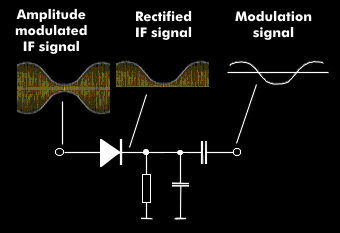demodulator
Functionally, a demodulator demodulates a modulated signal, i.e. it separates the modulation signal from the carrier signal.
The input signal of RF receivers, of radio and television sets, is always a modulated carrier signal. Depending on the modulation method, it can be amplitude, frequency or phase modulated. Depending on the device concept, the demodulator turns the modulated audio or video signal into audible audio or visible video. How such a demodulator is constructed depends exclusively on the modulation method.
For example, the demodulator for amplitude-modulated signals consists of a diode and a low-pass filter. The diode allows only the amplitude values of a certain polarity to pass, the low-pass filter provides the level linking of the peak values. The following capacitor separates the resulting DC voltage component.
In the case of frequency modulated signals, the audio or video signal is contained in the frequency change. The corresponding demodulation is performed with a discriminator, or a phase discriminator or quadrature discriminator. In the latter, the FM signal is combined in an AND gate with a phase-shifted portion of the same signal. The phase shift is caused by RLC gates which change the phase in proportion to the frequency near the resonant frequency.

